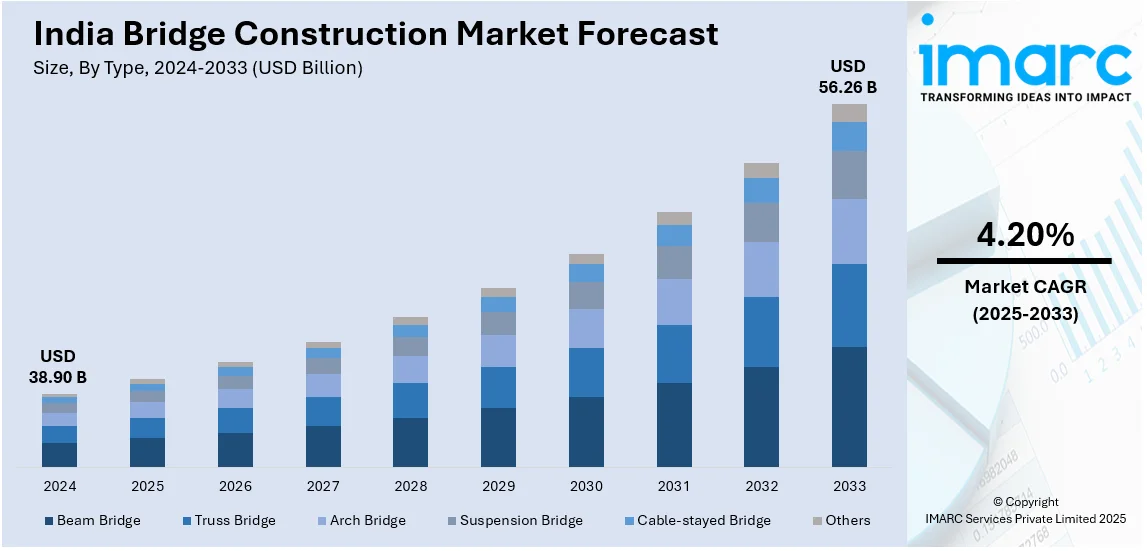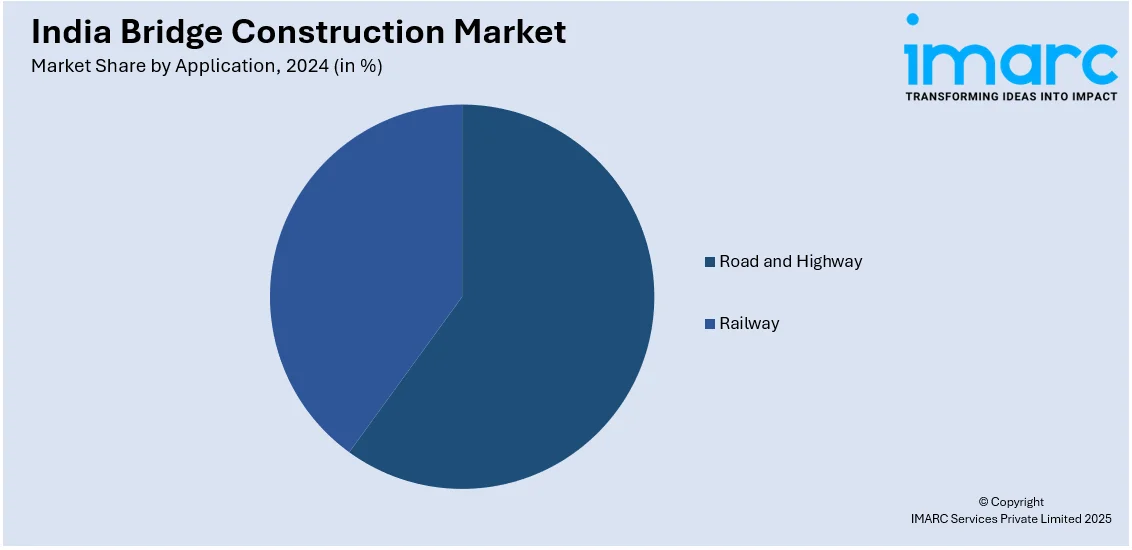
India Bridge Construction Market Size, Share, Trends and Forecast by Type, Material, Application, and Region, 2025-2033
India Bridge Construction Market Overview:
The India bridge construction market size reached USD 38.90 Billion in 2024. Looking forward, IMARC Group expects the market to reach USD 56.26 Billion by 2033, exhibiting a growth rate (CAGR) of 4.20% during 2025-2033. The market is driven by rapid urbanization, government infrastructure projects such as Bharatmala Pariyojana, and the need for improved connectivity. Public-private partnerships, technological advancements, and sustainable construction practices further fuel the India bridge construction market share. Rising investments in transportation networks and logistics efficiency also play a key role in expanding the sector.
|
Report Attribute
|
Key Statistics
|
|---|---|
|
Base Year
|
2024 |
|
Forecast Years
|
2025-2033
|
|
Historical Years
|
2019-2024
|
| Market Size in 2024 | USD 38.90 Billion |
| Market Forecast in 2033 | USD 56.26 Billion |
| Market Growth Rate (2025-2033) | 4.20% |
India Bridge Construction Market Trends:
Rising Demand for Infrastructure Development
The increasing demand for robust infrastructure is majorly driving the India bridge construction market growth. With rapid urbanization and the expansion of transportation networks, the government is prioritizing the development of bridges to enhance connectivity across rural and urban areas. Initiatives such as the Bharatmala Pariyojana, which aims to construct over 200 bridges and flyovers, are driving this trend. India has achieved great strides in infrastructure development, education infrastructure, and technology, with ₹10 Lakh Crore (approximately USD 125,000 Million) allocated for the fiscal year 2023-24, predominantly focused on roadways, railways, and aviation. 44 ministries are consolidated under the PM Gati Shakti National Master Plan, facilitating 208 major infrastructure projects estimated at ₹15.39 Lakh Crore (approximately USD 192,375 Million). Projects such as the Bharatmala Pariyojana and the Smart Cities Mission are improving connectivity, with the railway network increasing by 25,871 route kilometers between 2014 and 2023, promoting the bridge-building industry for smooth conveyance across the country. Additionally, the focus on improving logistics and reducing travel time has led to investments in advanced bridge construction technologies. The market is also witnessing a rise in public-private partnerships (PPPs), enabling faster project execution and funding. As India aims for a trillion economy, the emphasis on infrastructure development is expected to sustain the growth of the bridge construction sector in the coming years.

Adoption of Sustainable and Innovative Construction Practices
Sustainability and innovations are creating a positive India bridge construction market outlook. With growing environmental concerns, there is a shift toward using eco-friendly materials and energy-efficient construction techniques. Prefabricated bridge components, which reduce construction time and waste, are gaining popularity. On 4th February 2025, Renny Strips Pvt. Ltd. launched a 22MW solar power plant on 100 acres, emphasizing sustainable manufacturing and environmentally friendly steel for the Indian construction scaffolding industry. This program aims to be 50% less carbon intensive (with a target of 75%) than international standards for sustainable living and to cut energy costs by 33%. Renny Strips is set to lead the way in sustainable scaffolding solutions through this strategic move, which promises to reinvigorate India's positioning in green energy and set fresh benchmarks in construction practices. Additionally, the integration of smart technologies, such as IoT and AI, is enhancing the monitoring and maintenance of bridges, ensuring longevity and safety. The government is also promoting the use of recycled materials and green construction methods to align with global sustainability goals. This trend is further supported by stricter regulatory norms and the increasing awareness of climate change. As a result, companies are investing in research and development to adopt innovative solutions, making sustainability a cornerstone of the bridge construction industry in India.
India Bridge Construction Market Segmentation
IMARC Group provides an analysis of the key trends in each segment of the market, along with forecasts at the country level for 2025-2033. Our report has categorized the market based on type, material, and application.
Type Insights:
- Beam Bridge
- Truss Bridge
- Arch Bridge
- Suspension Bridge
- Cable-stayed Bridge
- Others
The report has provided a detailed breakup and analysis of the market based on the type. This includes beam bridge, truss bridge, arch bridge, suspension bridge, cable-stayed bridge, and others.
Material Insights:
- Steel
- Concrete
- Composite Materials
A detailed breakup and analysis of the market based on the material have also been provided in the report. This includes steel, concrete, and composite materials.
Application Insights:

- Road and Highway
- Railway
The report has provided a detailed breakup and analysis of the market based on the application. This includes road and highway, and railway.
Regional Insights:
- North India
- South India
- East India
- West India
The report has also provided a comprehensive analysis of all the major regional markets, which include North India, South India, East India, and West India.
Competitive Landscape:
The market research report has also provided a comprehensive analysis of the competitive landscape. Competitive analysis such as market structure, key player positioning, top winning strategies, competitive dashboard, and company evaluation quadrant has been covered in the report. Also, detailed profiles of all major companies have been provided.
India Bridge Construction Market News:
- October 15, 2024, Hindustan Construction Company (HCC) secured a contract of INR 10,316.40 Million (USD 122.71 Million) at Revas-Reddi Coastal Highway Maharashtra, a superelevated 4.3 km Bridge over Agardanda Creek. This project, consisting of two navigation spans, aims to improve regional connectivity by achieving a total horizontal clearance of 100 meters and a vertical clearance of 15 meters. The bridge is likely to provide a major impetus to the transport and economic growth of the Raigad District and has been designed as a cable-stayed superstructure.
India Bridge Construction Market Report Coverage:
| Report Features | Details |
|---|---|
| Base Year of the Analysis | 2024 |
| Historical Period | 2019-2024 |
| Forecast Period | 2025-2033 |
| Units | Billion USD |
| Scope of the Report |
Exploration of Historical Trends and Market Outlook, Industry Catalysts and Challenges, Segment-Wise Historical and Future Market Assessment:
|
| Types Covered | Beam Bridge, Truss Bridge, Arch Bridge, Suspension Bridge, Cable-stayed Bridge, Others |
| Materials Covered | Steel, Concrete, Composite Materials |
| Applications Covered | Road and Highway, Railway |
| Regions Covered | North India, South India, East India, West India |
| Customization Scope | 10% Free Customization |
| Post-Sale Analyst Support | 10-12 Weeks |
| Delivery Format | PDF and Excel through Email (We can also provide the editable version of the report in PPT/Word format on special request) |
Key Questions Answered in This Report:
- How has the India bridge construction market performed so far and how will it perform in the coming years?
- What is the breakup of the India bridge construction market on the basis of type?
- What is the breakup of the India bridge construction market on the basis of material?
- What is the breakup of the India bridge construction market on the basis of application?
- What is the breakup of the India bridge construction market on the basis of region?
- What are the various stages in the value chain of the India bridge construction market?
- What are the key driving factors and challenges in the India bridge construction market?
- What is the structure of the India bridge construction market and who are the key players?
- What is the degree of competition in the India bridge construction market?
Key Benefits for Stakeholders:
- IMARC’s industry report offers a comprehensive quantitative analysis of various market segments, historical and current market trends, market forecasts, and dynamics of the India bridge construction market from 2019-2033.
- The research report provides the latest information on the market drivers, challenges, and opportunities in the India bridge construction market.
- Porter's five forces analysis assist stakeholders in assessing the impact of new entrants, competitive rivalry, supplier power, buyer power, and the threat of substitution. It helps stakeholders to analyze the level of competition within the India bridge construction industry and its attractiveness.
- Competitive landscape allows stakeholders to understand their competitive environment and provides an insight into the current positions of key players in the market.
Need more help?
- Speak to our experienced analysts for insights on the current market scenarios.
- Include additional segments and countries to customize the report as per your requirement.
- Gain an unparalleled competitive advantage in your domain by understanding how to utilize the report and positively impacting your operations and revenue.
- For further assistance, please connect with our analysts.
 Inquire Before Buying
Inquire Before Buying
 Speak to an Analyst
Speak to an Analyst
 Request Brochure
Request Brochure
 Request Customization
Request Customization




.webp)




.webp)












